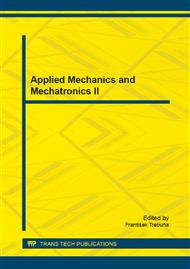p.300
p.306
p.313
p.321
p.327
p.339
p.349
p.357
p.363
The Effect of Magnetic Field on Magnetorheological Composites - Artificial Neural Network Based Modelling and Experiments
Abstract:
Looking for new applications of the available materials, such as magnetorheological elastomers (MERs) is an important element of machine design process. To this end it is necessary to determine their fundamental mechanical properties, including Young’s modulus and shear modulus. These properties are determined experimentally by testing the material in compression, tension and shear. In the case of the analysed group of materials the above-mentioned constants depend, inter alia, on the parameters of magnetic field acting on them. Therefore, it is necessary to determine the character and the extent of variation of the mechanical properties as a function of the physical constants characterising the active magnetic field, namely magnetic flux and magnetic intensity (field strength).This paper presents the results of static compression tests carried out on magnetorheological elastomers. The parameters measured during the static compression test were force and displacement at a pre-set magnetic flux. The maximum strength of the induced magnetic field was limited by the design parameters of the test set-up. In order to determine the behaviour of the material at greater values of magnetic strength and flux the properties of a real material were modelled with a neural network. The simulation was carried out using a simple, one-layer neural network. The chosen network training approach was error backpropagation. This approach enables approximation and predicting of changes of the properties of the tested material. The output results will enable deriving an analytical model of the tested MREs.
Info:
Periodical:
Pages:
327-336
Citation:
Online since:
November 2015
Authors:
Price:
Сopyright:
© 2015 Trans Tech Publications Ltd. All Rights Reserved
Share:
Citation:


